Health and Safety Implementation Challenges in the Workplace
VerifiedAdded on 2022/01/17
|22
|6443
|124
Report
AI Summary
This report, prepared for an Advanced National Diploma in Human Resource Management, delves into the critical importance of health and safety in the workplace. It emphasizes the need for a safe and healthy environment for employees, highlighting the various hazards and challenges that can arise. The report covers the basic objectives of workplace safety, the benefits of health and safety policies, and the role of training in ensuring a safe working environment. It also examines the difficulties encountered when implementing health and safety measures, including challenges related to employee awareness, cost, and management commitment. The report underscores the significance of proactive safety measures to prevent accidents, reduce injuries, and improve productivity, ultimately aiming to create a safer and more efficient workplace. The report also discusses how employers must understand that safety goes well beyond their employees and the importance of minimizing legal liabilities.
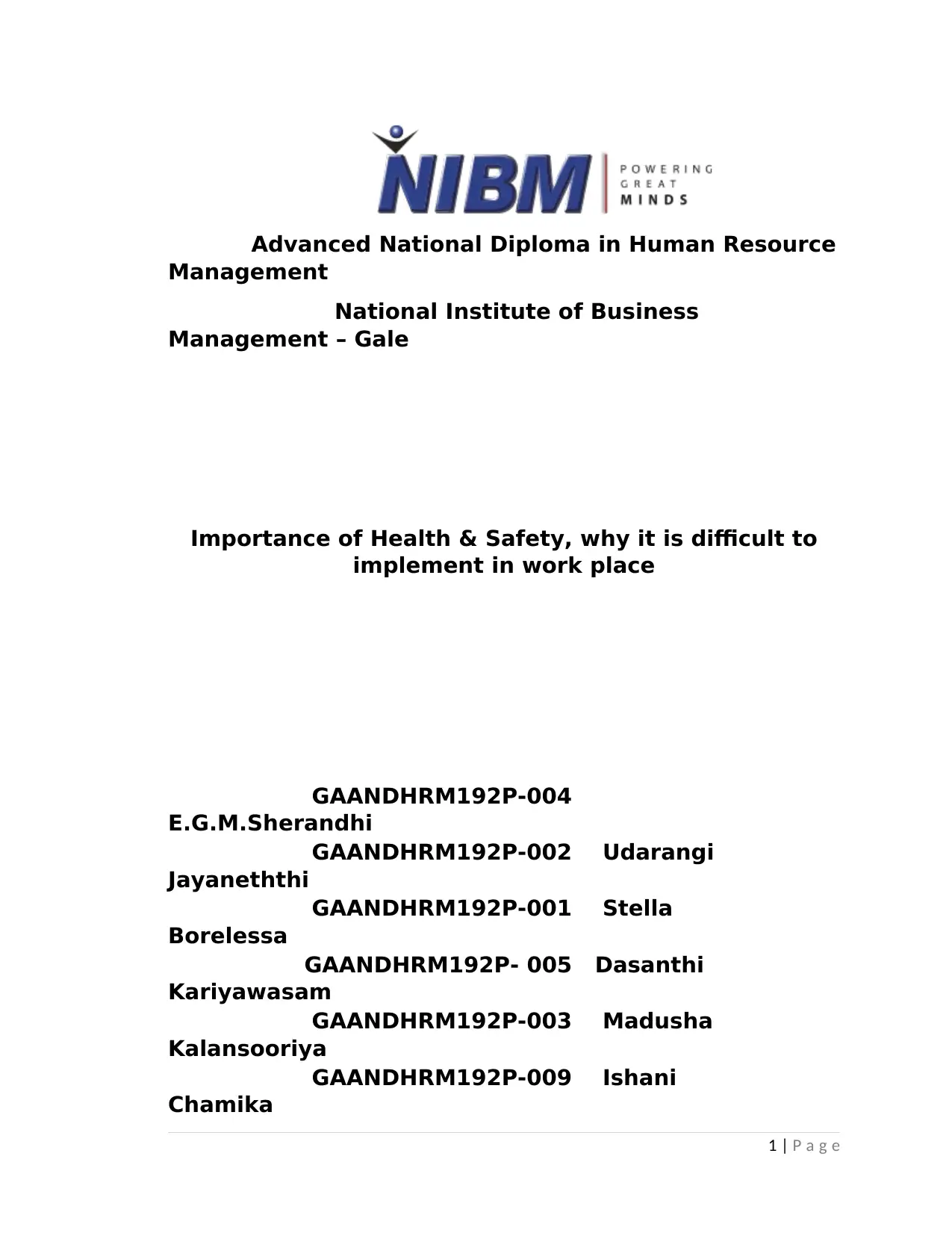
Advanced National Diploma in Human Resource
Management
National Institute of Business
Management – Gale
Importance of Health & Safety, why it is difficult to
implement in work place
GAANDHRM192P-004
E.G.M.Sherandhi
GAANDHRM192P-002 Udarangi
Jayaneththi
GAANDHRM192P-001 Stella
Borelessa
GAANDHRM192P- 005 Dasanthi
Kariyawasam
GAANDHRM192P-003 Madusha
Kalansooriya
GAANDHRM192P-009 Ishani
Chamika
1 | P a g e
Management
National Institute of Business
Management – Gale
Importance of Health & Safety, why it is difficult to
implement in work place
GAANDHRM192P-004
E.G.M.Sherandhi
GAANDHRM192P-002 Udarangi
Jayaneththi
GAANDHRM192P-001 Stella
Borelessa
GAANDHRM192P- 005 Dasanthi
Kariyawasam
GAANDHRM192P-003 Madusha
Kalansooriya
GAANDHRM192P-009 Ishani
Chamika
1 | P a g e
Paraphrase This Document
Need a fresh take? Get an instant paraphrase of this document with our AI Paraphraser

GAANDHRM192P-007 Chanuka
Sandeepa
22/02/2021
Date of
Submission
ACKNOWLEDGMENT
First, we’d love to thank our beloved lecturer Mr. Thilak Devendra, for
providing his valuable time and guidance in elaborating view of studying the project
details.
We’d also like to thank all our family members for their kind co-operations
advice and encouragement during the long and arduous task of preparing this report and
carrying out the project. We would once again like to express our heartiest gratitude to all
who helped us directly or indirectly throughout this project work.
We are also thankful to the members of this project, for extending their heartfelt
guidance through this project work. Without their supervision and many hours of devoted
guidance, stimulating & constructive criticism, this thesis would never come out in this
form.
Last not but least I would like to express gratitude to all who helped us through
the period and gave us proper response and co-operating in our various activities with
their patience.
2 | P a g e
Sandeepa
22/02/2021
Date of
Submission
ACKNOWLEDGMENT
First, we’d love to thank our beloved lecturer Mr. Thilak Devendra, for
providing his valuable time and guidance in elaborating view of studying the project
details.
We’d also like to thank all our family members for their kind co-operations
advice and encouragement during the long and arduous task of preparing this report and
carrying out the project. We would once again like to express our heartiest gratitude to all
who helped us directly or indirectly throughout this project work.
We are also thankful to the members of this project, for extending their heartfelt
guidance through this project work. Without their supervision and many hours of devoted
guidance, stimulating & constructive criticism, this thesis would never come out in this
form.
Last not but least I would like to express gratitude to all who helped us through
the period and gave us proper response and co-operating in our various activities with
their patience.
2 | P a g e
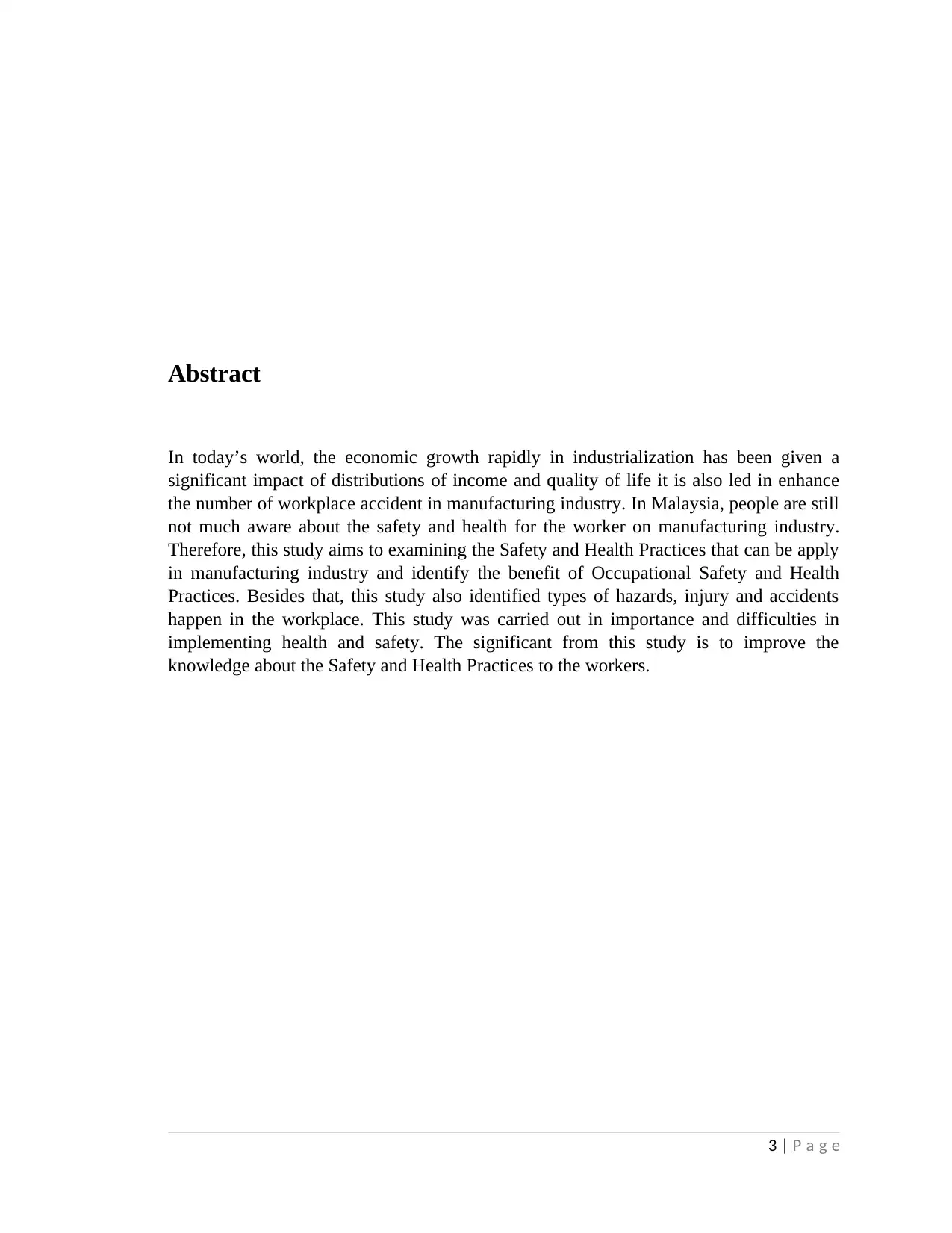
Abstract
In today’s world, the economic growth rapidly in industrialization has been given a
significant impact of distributions of income and quality of life it is also led in enhance
the number of workplace accident in manufacturing industry. In Malaysia, people are still
not much aware about the safety and health for the worker on manufacturing industry.
Therefore, this study aims to examining the Safety and Health Practices that can be apply
in manufacturing industry and identify the benefit of Occupational Safety and Health
Practices. Besides that, this study also identified types of hazards, injury and accidents
happen in the workplace. This study was carried out in importance and difficulties in
implementing health and safety. The significant from this study is to improve the
knowledge about the Safety and Health Practices to the workers.
3 | P a g e
In today’s world, the economic growth rapidly in industrialization has been given a
significant impact of distributions of income and quality of life it is also led in enhance
the number of workplace accident in manufacturing industry. In Malaysia, people are still
not much aware about the safety and health for the worker on manufacturing industry.
Therefore, this study aims to examining the Safety and Health Practices that can be apply
in manufacturing industry and identify the benefit of Occupational Safety and Health
Practices. Besides that, this study also identified types of hazards, injury and accidents
happen in the workplace. This study was carried out in importance and difficulties in
implementing health and safety. The significant from this study is to improve the
knowledge about the Safety and Health Practices to the workers.
3 | P a g e
⊘ This is a preview!⊘
Do you want full access?
Subscribe today to unlock all pages.

Trusted by 1+ million students worldwide
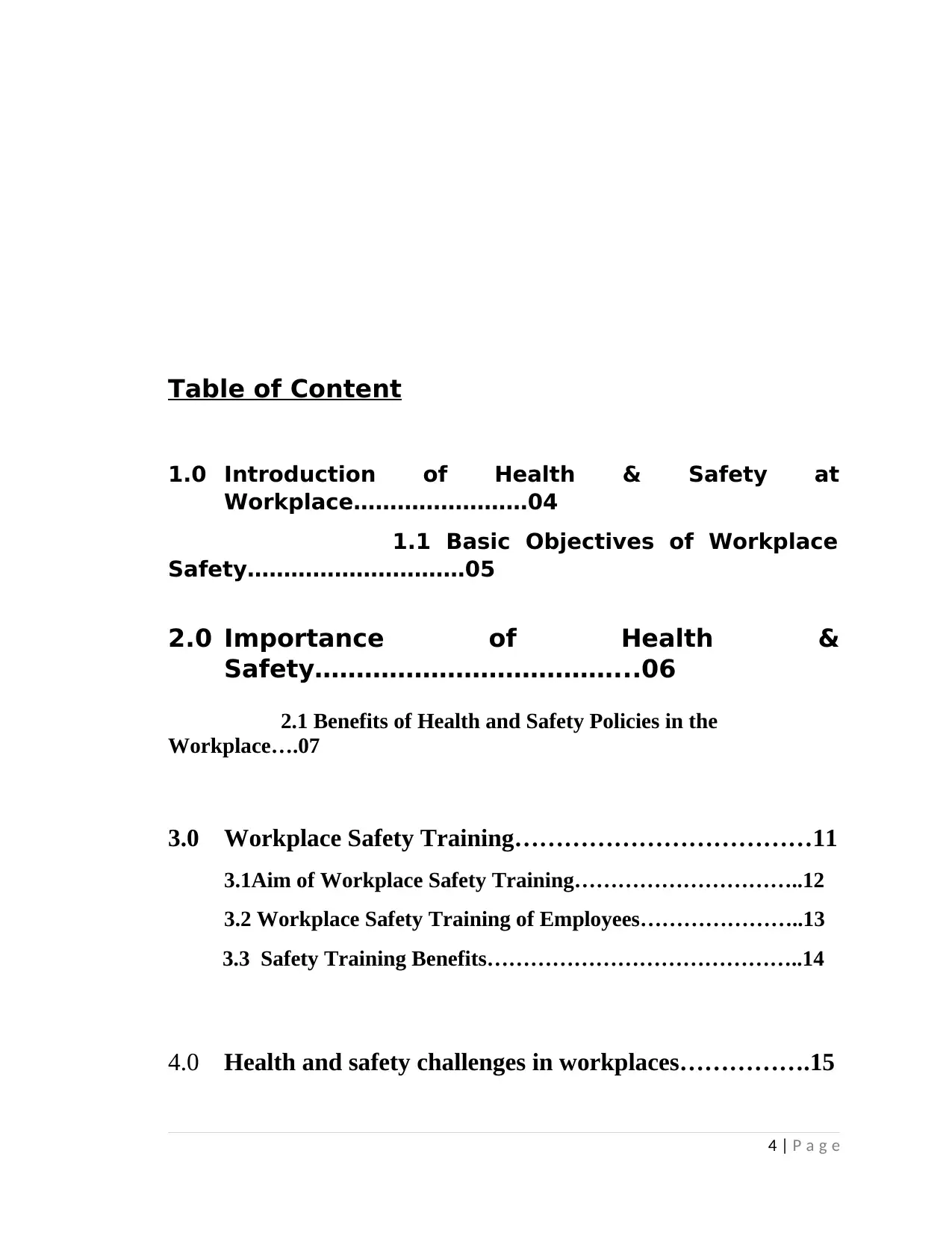
Table of Content
1.0 Introduction of Health & Safety at
Workplace……………………04
1.1 Basic Objectives of Workplace
Safety…………………………05
2.0 Importance of Health &
Safety………………………………...06
2.1 Benefits of Health and Safety Policies in the
Workplace….07
3.0 Workplace Safety Training………………………………11
3.1Aim of Workplace Safety Training…………………………..12
3.2 Workplace Safety Training of Employees…………………..13
3.3 Safety Training Benefits……………………………………..14
4.0 Health and safety challenges in workplaces…………….15
4 | P a g e
1.0 Introduction of Health & Safety at
Workplace……………………04
1.1 Basic Objectives of Workplace
Safety…………………………05
2.0 Importance of Health &
Safety………………………………...06
2.1 Benefits of Health and Safety Policies in the
Workplace….07
3.0 Workplace Safety Training………………………………11
3.1Aim of Workplace Safety Training…………………………..12
3.2 Workplace Safety Training of Employees…………………..13
3.3 Safety Training Benefits……………………………………..14
4.0 Health and safety challenges in workplaces…………….15
4 | P a g e
Paraphrase This Document
Need a fresh take? Get an instant paraphrase of this document with our AI Paraphraser
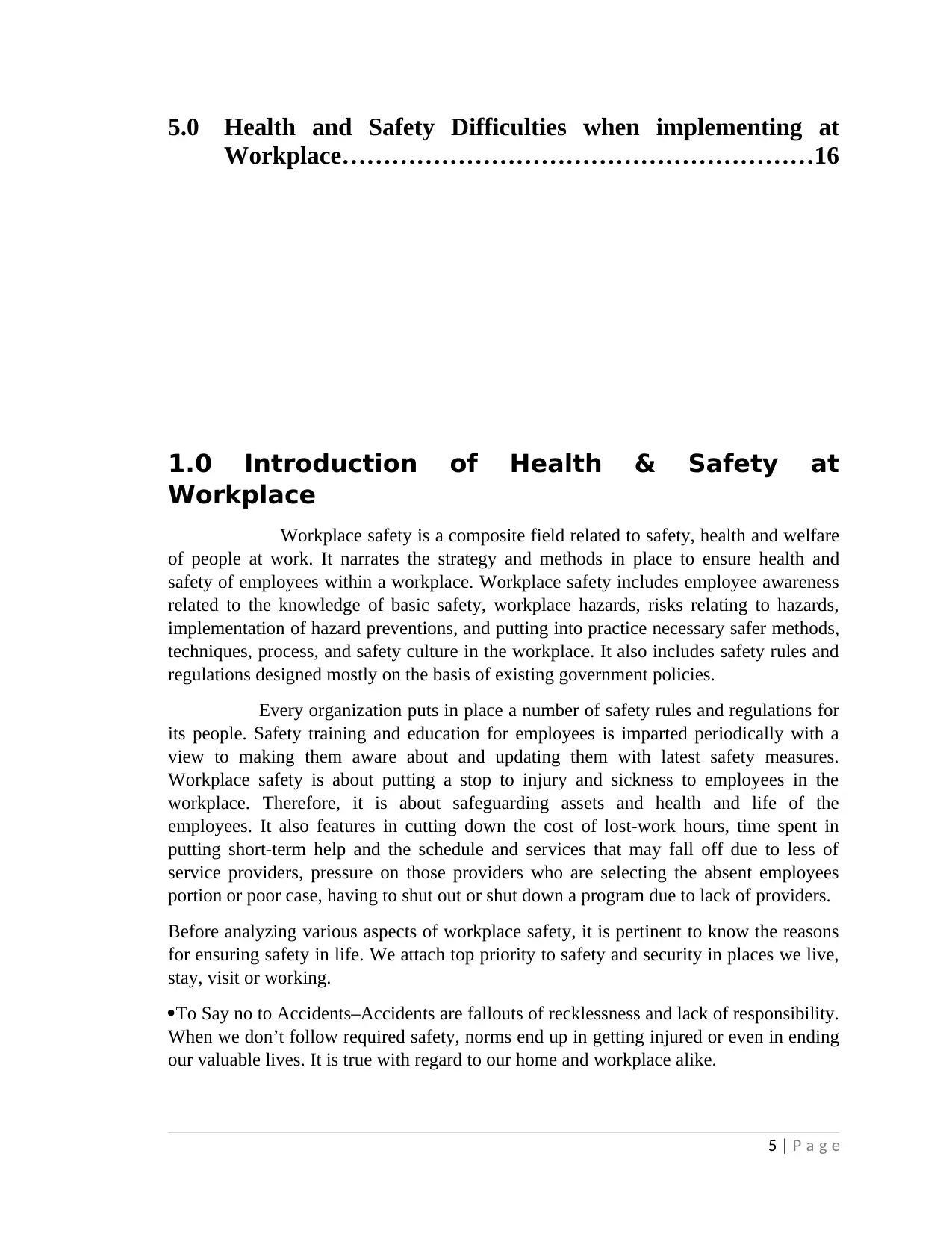
5.0 Health and Safety Difficulties when implementing at
Workplace…………………………………………………16
1.0 Introduction of Health & Safety at
Workplace
Workplace safety is a composite field related to safety, health and welfare
of people at work. It narrates the strategy and methods in place to ensure health and
safety of employees within a workplace. Workplace safety includes employee awareness
related to the knowledge of basic safety, workplace hazards, risks relating to hazards,
implementation of hazard preventions, and putting into practice necessary safer methods,
techniques, process, and safety culture in the workplace. It also includes safety rules and
regulations designed mostly on the basis of existing government policies.
Every organization puts in place a number of safety rules and regulations for
its people. Safety training and education for employees is imparted periodically with a
view to making them aware about and updating them with latest safety measures.
Workplace safety is about putting a stop to injury and sickness to employees in the
workplace. Therefore, it is about safeguarding assets and health and life of the
employees. It also features in cutting down the cost of lost-work hours, time spent in
putting short-term help and the schedule and services that may fall off due to less of
service providers, pressure on those providers who are selecting the absent employees
portion or poor case, having to shut out or shut down a program due to lack of providers.
Before analyzing various aspects of workplace safety, it is pertinent to know the reasons
for ensuring safety in life. We attach top priority to safety and security in places we live,
stay, visit or working.
To Say no to Accidents–Accidents are fallouts of recklessness and lack of responsibility.
When we don’t follow required safety, norms end up in getting injured or even in ending
our valuable lives. It is true with regard to our home and workplace alike.
5 | P a g e
Workplace…………………………………………………16
1.0 Introduction of Health & Safety at
Workplace
Workplace safety is a composite field related to safety, health and welfare
of people at work. It narrates the strategy and methods in place to ensure health and
safety of employees within a workplace. Workplace safety includes employee awareness
related to the knowledge of basic safety, workplace hazards, risks relating to hazards,
implementation of hazard preventions, and putting into practice necessary safer methods,
techniques, process, and safety culture in the workplace. It also includes safety rules and
regulations designed mostly on the basis of existing government policies.
Every organization puts in place a number of safety rules and regulations for
its people. Safety training and education for employees is imparted periodically with a
view to making them aware about and updating them with latest safety measures.
Workplace safety is about putting a stop to injury and sickness to employees in the
workplace. Therefore, it is about safeguarding assets and health and life of the
employees. It also features in cutting down the cost of lost-work hours, time spent in
putting short-term help and the schedule and services that may fall off due to less of
service providers, pressure on those providers who are selecting the absent employees
portion or poor case, having to shut out or shut down a program due to lack of providers.
Before analyzing various aspects of workplace safety, it is pertinent to know the reasons
for ensuring safety in life. We attach top priority to safety and security in places we live,
stay, visit or working.
To Say no to Accidents–Accidents are fallouts of recklessness and lack of responsibility.
When we don’t follow required safety, norms end up in getting injured or even in ending
our valuable lives. It is true with regard to our home and workplace alike.
5 | P a g e
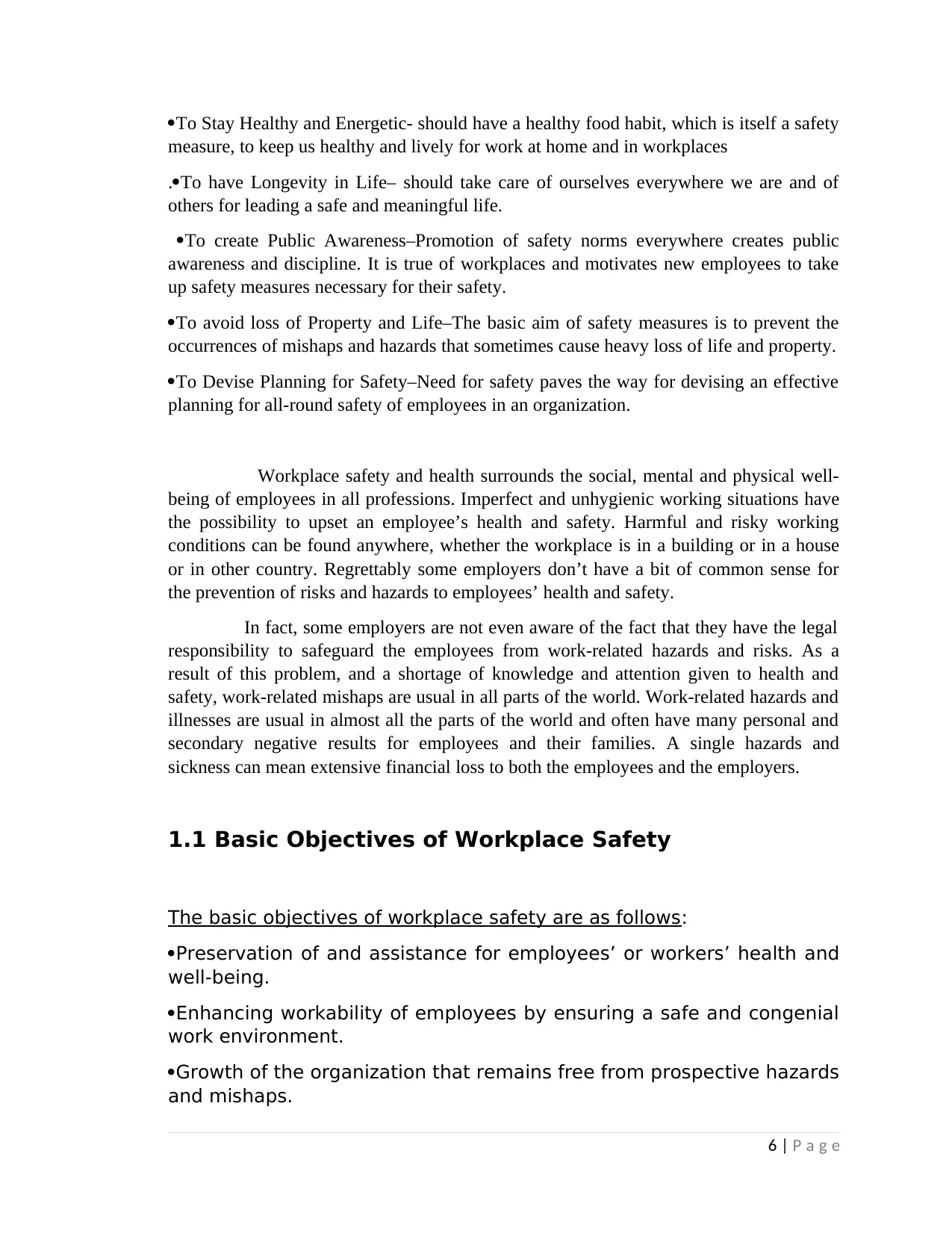
To Stay Healthy and Energetic- should have a healthy food habit, which is itself a safety
measure, to keep us healthy and lively for work at home and in workplaces
.To have Longevity in Life– should take care of ourselves everywhere we are and of
others for leading a safe and meaningful life.
To create Public Awareness–Promotion of safety norms everywhere creates public
awareness and discipline. It is true of workplaces and motivates new employees to take
up safety measures necessary for their safety.
To avoid loss of Property and Life–The basic aim of safety measures is to prevent the
occurrences of mishaps and hazards that sometimes cause heavy loss of life and property.
To Devise Planning for Safety–Need for safety paves the way for devising an effective
planning for all-round safety of employees in an organization.
Workplace safety and health surrounds the social, mental and physical well-
being of employees in all professions. Imperfect and unhygienic working situations have
the possibility to upset an employee’s health and safety. Harmful and risky working
conditions can be found anywhere, whether the workplace is in a building or in a house
or in other country. Regrettably some employers don’t have a bit of common sense for
the prevention of risks and hazards to employees’ health and safety.
In fact, some employers are not even aware of the fact that they have the legal
responsibility to safeguard the employees from work-related hazards and risks. As a
result of this problem, and a shortage of knowledge and attention given to health and
safety, work-related mishaps are usual in all parts of the world. Work-related hazards and
illnesses are usual in almost all the parts of the world and often have many personal and
secondary negative results for employees and their families. A single hazards and
sickness can mean extensive financial loss to both the employees and the employers.
1.1 Basic Objectives of Workplace Safety
The basic objectives of workplace safety are as follows:
Preservation of and assistance for employees’ or workers’ health and
well-being.
Enhancing workability of employees by ensuring a safe and congenial
work environment.
Growth of the organization that remains free from prospective hazards
and mishaps.
6 | P a g e
measure, to keep us healthy and lively for work at home and in workplaces
.To have Longevity in Life– should take care of ourselves everywhere we are and of
others for leading a safe and meaningful life.
To create Public Awareness–Promotion of safety norms everywhere creates public
awareness and discipline. It is true of workplaces and motivates new employees to take
up safety measures necessary for their safety.
To avoid loss of Property and Life–The basic aim of safety measures is to prevent the
occurrences of mishaps and hazards that sometimes cause heavy loss of life and property.
To Devise Planning for Safety–Need for safety paves the way for devising an effective
planning for all-round safety of employees in an organization.
Workplace safety and health surrounds the social, mental and physical well-
being of employees in all professions. Imperfect and unhygienic working situations have
the possibility to upset an employee’s health and safety. Harmful and risky working
conditions can be found anywhere, whether the workplace is in a building or in a house
or in other country. Regrettably some employers don’t have a bit of common sense for
the prevention of risks and hazards to employees’ health and safety.
In fact, some employers are not even aware of the fact that they have the legal
responsibility to safeguard the employees from work-related hazards and risks. As a
result of this problem, and a shortage of knowledge and attention given to health and
safety, work-related mishaps are usual in all parts of the world. Work-related hazards and
illnesses are usual in almost all the parts of the world and often have many personal and
secondary negative results for employees and their families. A single hazards and
sickness can mean extensive financial loss to both the employees and the employers.
1.1 Basic Objectives of Workplace Safety
The basic objectives of workplace safety are as follows:
Preservation of and assistance for employees’ or workers’ health and
well-being.
Enhancing workability of employees by ensuring a safe and congenial
work environment.
Growth of the organization that remains free from prospective hazards
and mishaps.
6 | P a g e
⊘ This is a preview!⊘
Do you want full access?
Subscribe today to unlock all pages.

Trusted by 1+ million students worldwide
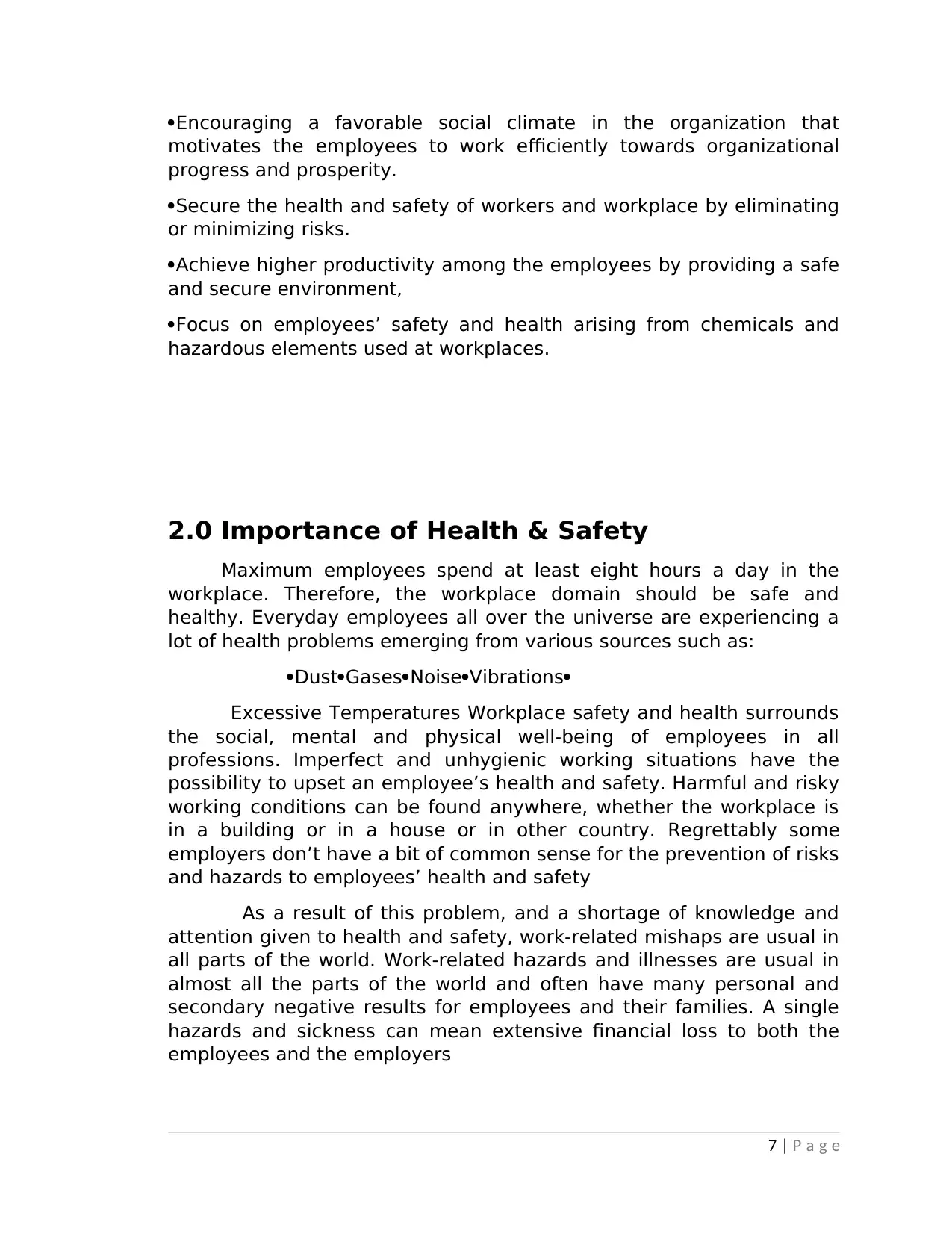
Encouraging a favorable social climate in the organization that
motivates the employees to work efficiently towards organizational
progress and prosperity.
Secure the health and safety of workers and workplace by eliminating
or minimizing risks.
Achieve higher productivity among the employees by providing a safe
and secure environment,
Focus on employees’ safety and health arising from chemicals and
hazardous elements used at workplaces.
2.0 Importance of Health & Safety
Maximum employees spend at least eight hours a day in the
workplace. Therefore, the workplace domain should be safe and
healthy. Everyday employees all over the universe are experiencing a
lot of health problems emerging from various sources such as:
DustGasesNoiseVibrations
Excessive Temperatures Workplace safety and health surrounds
the social, mental and physical well-being of employees in all
professions. Imperfect and unhygienic working situations have the
possibility to upset an employee’s health and safety. Harmful and risky
working conditions can be found anywhere, whether the workplace is
in a building or in a house or in other country. Regrettably some
employers don’t have a bit of common sense for the prevention of risks
and hazards to employees’ health and safety
As a result of this problem, and a shortage of knowledge and
attention given to health and safety, work-related mishaps are usual in
all parts of the world. Work-related hazards and illnesses are usual in
almost all the parts of the world and often have many personal and
secondary negative results for employees and their families. A single
hazards and sickness can mean extensive financial loss to both the
employees and the employers
7 | P a g e
motivates the employees to work efficiently towards organizational
progress and prosperity.
Secure the health and safety of workers and workplace by eliminating
or minimizing risks.
Achieve higher productivity among the employees by providing a safe
and secure environment,
Focus on employees’ safety and health arising from chemicals and
hazardous elements used at workplaces.
2.0 Importance of Health & Safety
Maximum employees spend at least eight hours a day in the
workplace. Therefore, the workplace domain should be safe and
healthy. Everyday employees all over the universe are experiencing a
lot of health problems emerging from various sources such as:
DustGasesNoiseVibrations
Excessive Temperatures Workplace safety and health surrounds
the social, mental and physical well-being of employees in all
professions. Imperfect and unhygienic working situations have the
possibility to upset an employee’s health and safety. Harmful and risky
working conditions can be found anywhere, whether the workplace is
in a building or in a house or in other country. Regrettably some
employers don’t have a bit of common sense for the prevention of risks
and hazards to employees’ health and safety
As a result of this problem, and a shortage of knowledge and
attention given to health and safety, work-related mishaps are usual in
all parts of the world. Work-related hazards and illnesses are usual in
almost all the parts of the world and often have many personal and
secondary negative results for employees and their families. A single
hazards and sickness can mean extensive financial loss to both the
employees and the employers
7 | P a g e
Paraphrase This Document
Need a fresh take? Get an instant paraphrase of this document with our AI Paraphraser
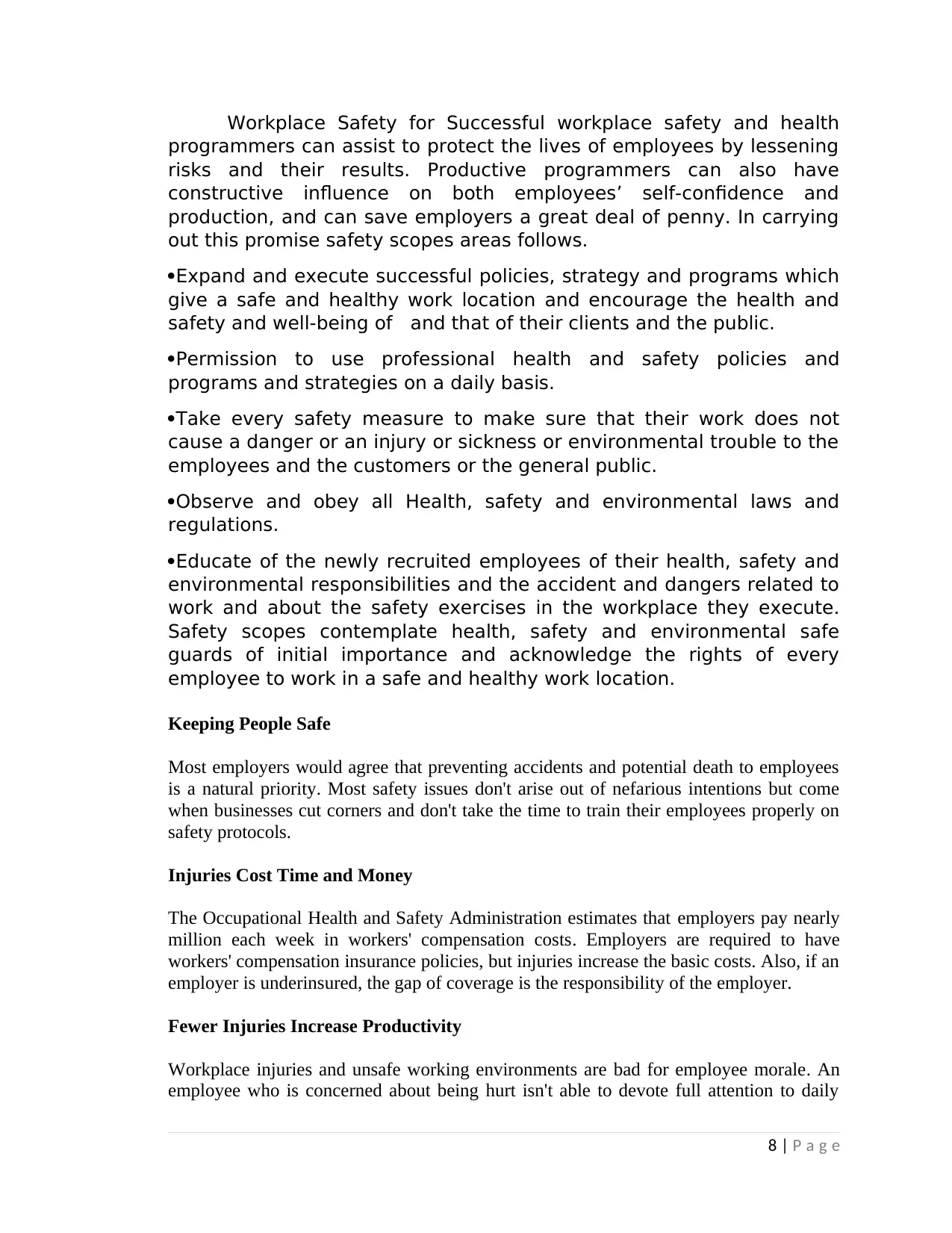
Workplace Safety for Successful workplace safety and health
programmers can assist to protect the lives of employees by lessening
risks and their results. Productive programmers can also have
constructive influence on both employees’ self-confidence and
production, and can save employers a great deal of penny. In carrying
out this promise safety scopes areas follows.
Expand and execute successful policies, strategy and programs which
give a safe and healthy work location and encourage the health and
safety and well-being of and that of their clients and the public.
Permission to use professional health and safety policies and
programs and strategies on a daily basis.
Take every safety measure to make sure that their work does not
cause a danger or an injury or sickness or environmental trouble to the
employees and the customers or the general public.
Observe and obey all Health, safety and environmental laws and
regulations.
Educate of the newly recruited employees of their health, safety and
environmental responsibilities and the accident and dangers related to
work and about the safety exercises in the workplace they execute.
Safety scopes contemplate health, safety and environmental safe
guards of initial importance and acknowledge the rights of every
employee to work in a safe and healthy work location.
Keeping People Safe
Most employers would agree that preventing accidents and potential death to employees
is a natural priority. Most safety issues don't arise out of nefarious intentions but come
when businesses cut corners and don't take the time to train their employees properly on
safety protocols.
Injuries Cost Time and Money
The Occupational Health and Safety Administration estimates that employers pay nearly
million each week in workers' compensation costs. Employers are required to have
workers' compensation insurance policies, but injuries increase the basic costs. Also, if an
employer is underinsured, the gap of coverage is the responsibility of the employer.
Fewer Injuries Increase Productivity
Workplace injuries and unsafe working environments are bad for employee morale. An
employee who is concerned about being hurt isn't able to devote full attention to daily
8 | P a g e
programmers can assist to protect the lives of employees by lessening
risks and their results. Productive programmers can also have
constructive influence on both employees’ self-confidence and
production, and can save employers a great deal of penny. In carrying
out this promise safety scopes areas follows.
Expand and execute successful policies, strategy and programs which
give a safe and healthy work location and encourage the health and
safety and well-being of and that of their clients and the public.
Permission to use professional health and safety policies and
programs and strategies on a daily basis.
Take every safety measure to make sure that their work does not
cause a danger or an injury or sickness or environmental trouble to the
employees and the customers or the general public.
Observe and obey all Health, safety and environmental laws and
regulations.
Educate of the newly recruited employees of their health, safety and
environmental responsibilities and the accident and dangers related to
work and about the safety exercises in the workplace they execute.
Safety scopes contemplate health, safety and environmental safe
guards of initial importance and acknowledge the rights of every
employee to work in a safe and healthy work location.
Keeping People Safe
Most employers would agree that preventing accidents and potential death to employees
is a natural priority. Most safety issues don't arise out of nefarious intentions but come
when businesses cut corners and don't take the time to train their employees properly on
safety protocols.
Injuries Cost Time and Money
The Occupational Health and Safety Administration estimates that employers pay nearly
million each week in workers' compensation costs. Employers are required to have
workers' compensation insurance policies, but injuries increase the basic costs. Also, if an
employer is underinsured, the gap of coverage is the responsibility of the employer.
Fewer Injuries Increase Productivity
Workplace injuries and unsafe working environments are bad for employee morale. An
employee who is concerned about being hurt isn't able to devote full attention to daily
8 | P a g e
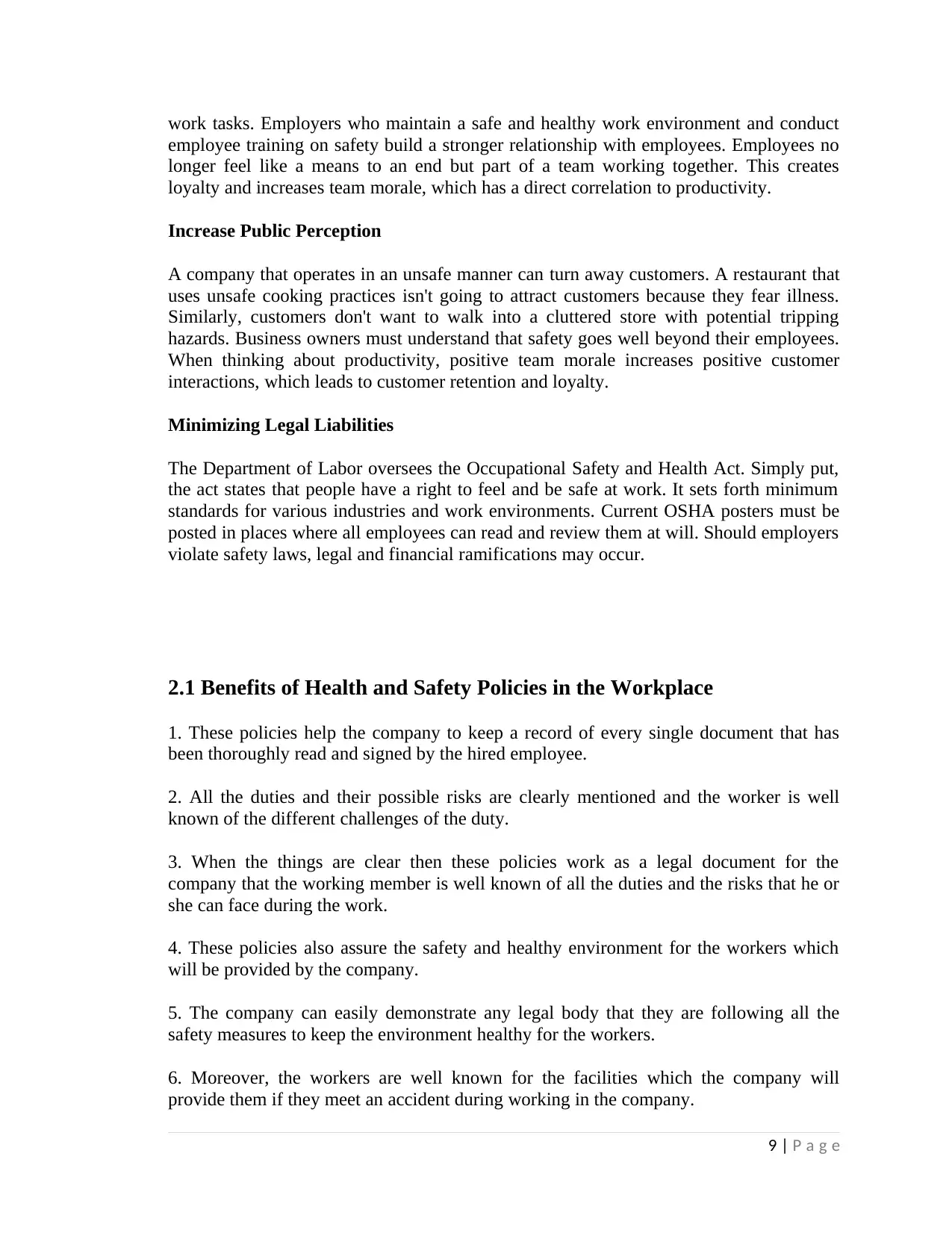
work tasks. Employers who maintain a safe and healthy work environment and conduct
employee training on safety build a stronger relationship with employees. Employees no
longer feel like a means to an end but part of a team working together. This creates
loyalty and increases team morale, which has a direct correlation to productivity.
Increase Public Perception
A company that operates in an unsafe manner can turn away customers. A restaurant that
uses unsafe cooking practices isn't going to attract customers because they fear illness.
Similarly, customers don't want to walk into a cluttered store with potential tripping
hazards. Business owners must understand that safety goes well beyond their employees.
When thinking about productivity, positive team morale increases positive customer
interactions, which leads to customer retention and loyalty.
Minimizing Legal Liabilities
The Department of Labor oversees the Occupational Safety and Health Act. Simply put,
the act states that people have a right to feel and be safe at work. It sets forth minimum
standards for various industries and work environments. Current OSHA posters must be
posted in places where all employees can read and review them at will. Should employers
violate safety laws, legal and financial ramifications may occur.
2.1 Benefits of Health and Safety Policies in the Workplace
1. These policies help the company to keep a record of every single document that has
been thoroughly read and signed by the hired employee.
2. All the duties and their possible risks are clearly mentioned and the worker is well
known of the different challenges of the duty.
3. When the things are clear then these policies work as a legal document for the
company that the working member is well known of all the duties and the risks that he or
she can face during the work.
4. These policies also assure the safety and healthy environment for the workers which
will be provided by the company.
5. The company can easily demonstrate any legal body that they are following all the
safety measures to keep the environment healthy for the workers.
6. Moreover, the workers are well known for the facilities which the company will
provide them if they meet an accident during working in the company.
9 | P a g e
employee training on safety build a stronger relationship with employees. Employees no
longer feel like a means to an end but part of a team working together. This creates
loyalty and increases team morale, which has a direct correlation to productivity.
Increase Public Perception
A company that operates in an unsafe manner can turn away customers. A restaurant that
uses unsafe cooking practices isn't going to attract customers because they fear illness.
Similarly, customers don't want to walk into a cluttered store with potential tripping
hazards. Business owners must understand that safety goes well beyond their employees.
When thinking about productivity, positive team morale increases positive customer
interactions, which leads to customer retention and loyalty.
Minimizing Legal Liabilities
The Department of Labor oversees the Occupational Safety and Health Act. Simply put,
the act states that people have a right to feel and be safe at work. It sets forth minimum
standards for various industries and work environments. Current OSHA posters must be
posted in places where all employees can read and review them at will. Should employers
violate safety laws, legal and financial ramifications may occur.
2.1 Benefits of Health and Safety Policies in the Workplace
1. These policies help the company to keep a record of every single document that has
been thoroughly read and signed by the hired employee.
2. All the duties and their possible risks are clearly mentioned and the worker is well
known of the different challenges of the duty.
3. When the things are clear then these policies work as a legal document for the
company that the working member is well known of all the duties and the risks that he or
she can face during the work.
4. These policies also assure the safety and healthy environment for the workers which
will be provided by the company.
5. The company can easily demonstrate any legal body that they are following all the
safety measures to keep the environment healthy for the workers.
6. Moreover, the workers are well known for the facilities which the company will
provide them if they meet an accident during working in the company.
9 | P a g e
⊘ This is a preview!⊘
Do you want full access?
Subscribe today to unlock all pages.

Trusted by 1+ million students worldwide
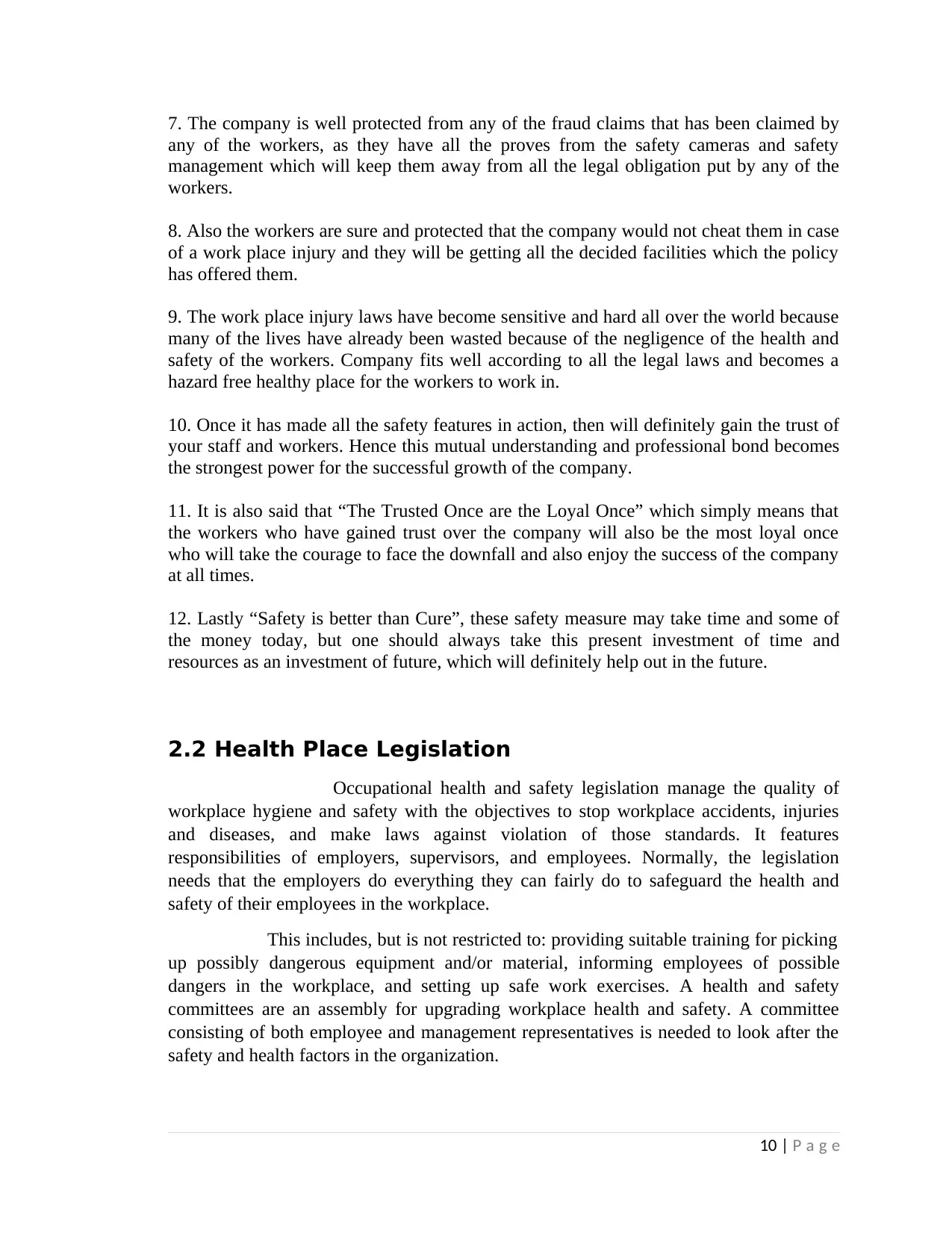
7. The company is well protected from any of the fraud claims that has been claimed by
any of the workers, as they have all the proves from the safety cameras and safety
management which will keep them away from all the legal obligation put by any of the
workers.
8. Also the workers are sure and protected that the company would not cheat them in case
of a work place injury and they will be getting all the decided facilities which the policy
has offered them.
9. The work place injury laws have become sensitive and hard all over the world because
many of the lives have already been wasted because of the negligence of the health and
safety of the workers. Company fits well according to all the legal laws and becomes a
hazard free healthy place for the workers to work in.
10. Once it has made all the safety features in action, then will definitely gain the trust of
your staff and workers. Hence this mutual understanding and professional bond becomes
the strongest power for the successful growth of the company.
11. It is also said that “The Trusted Once are the Loyal Once” which simply means that
the workers who have gained trust over the company will also be the most loyal once
who will take the courage to face the downfall and also enjoy the success of the company
at all times.
12. Lastly “Safety is better than Cure”, these safety measure may take time and some of
the money today, but one should always take this present investment of time and
resources as an investment of future, which will definitely help out in the future.
2.2 Health Place Legislation
Occupational health and safety legislation manage the quality of
workplace hygiene and safety with the objectives to stop workplace accidents, injuries
and diseases, and make laws against violation of those standards. It features
responsibilities of employers, supervisors, and employees. Normally, the legislation
needs that the employers do everything they can fairly do to safeguard the health and
safety of their employees in the workplace.
This includes, but is not restricted to: providing suitable training for picking
up possibly dangerous equipment and/or material, informing employees of possible
dangers in the workplace, and setting up safe work exercises. A health and safety
committees are an assembly for upgrading workplace health and safety. A committee
consisting of both employee and management representatives is needed to look after the
safety and health factors in the organization.
10 | P a g e
any of the workers, as they have all the proves from the safety cameras and safety
management which will keep them away from all the legal obligation put by any of the
workers.
8. Also the workers are sure and protected that the company would not cheat them in case
of a work place injury and they will be getting all the decided facilities which the policy
has offered them.
9. The work place injury laws have become sensitive and hard all over the world because
many of the lives have already been wasted because of the negligence of the health and
safety of the workers. Company fits well according to all the legal laws and becomes a
hazard free healthy place for the workers to work in.
10. Once it has made all the safety features in action, then will definitely gain the trust of
your staff and workers. Hence this mutual understanding and professional bond becomes
the strongest power for the successful growth of the company.
11. It is also said that “The Trusted Once are the Loyal Once” which simply means that
the workers who have gained trust over the company will also be the most loyal once
who will take the courage to face the downfall and also enjoy the success of the company
at all times.
12. Lastly “Safety is better than Cure”, these safety measure may take time and some of
the money today, but one should always take this present investment of time and
resources as an investment of future, which will definitely help out in the future.
2.2 Health Place Legislation
Occupational health and safety legislation manage the quality of
workplace hygiene and safety with the objectives to stop workplace accidents, injuries
and diseases, and make laws against violation of those standards. It features
responsibilities of employers, supervisors, and employees. Normally, the legislation
needs that the employers do everything they can fairly do to safeguard the health and
safety of their employees in the workplace.
This includes, but is not restricted to: providing suitable training for picking
up possibly dangerous equipment and/or material, informing employees of possible
dangers in the workplace, and setting up safe work exercises. A health and safety
committees are an assembly for upgrading workplace health and safety. A committee
consisting of both employee and management representatives is needed to look after the
safety and health factors in the organization.
10 | P a g e
Paraphrase This Document
Need a fresh take? Get an instant paraphrase of this document with our AI Paraphraser
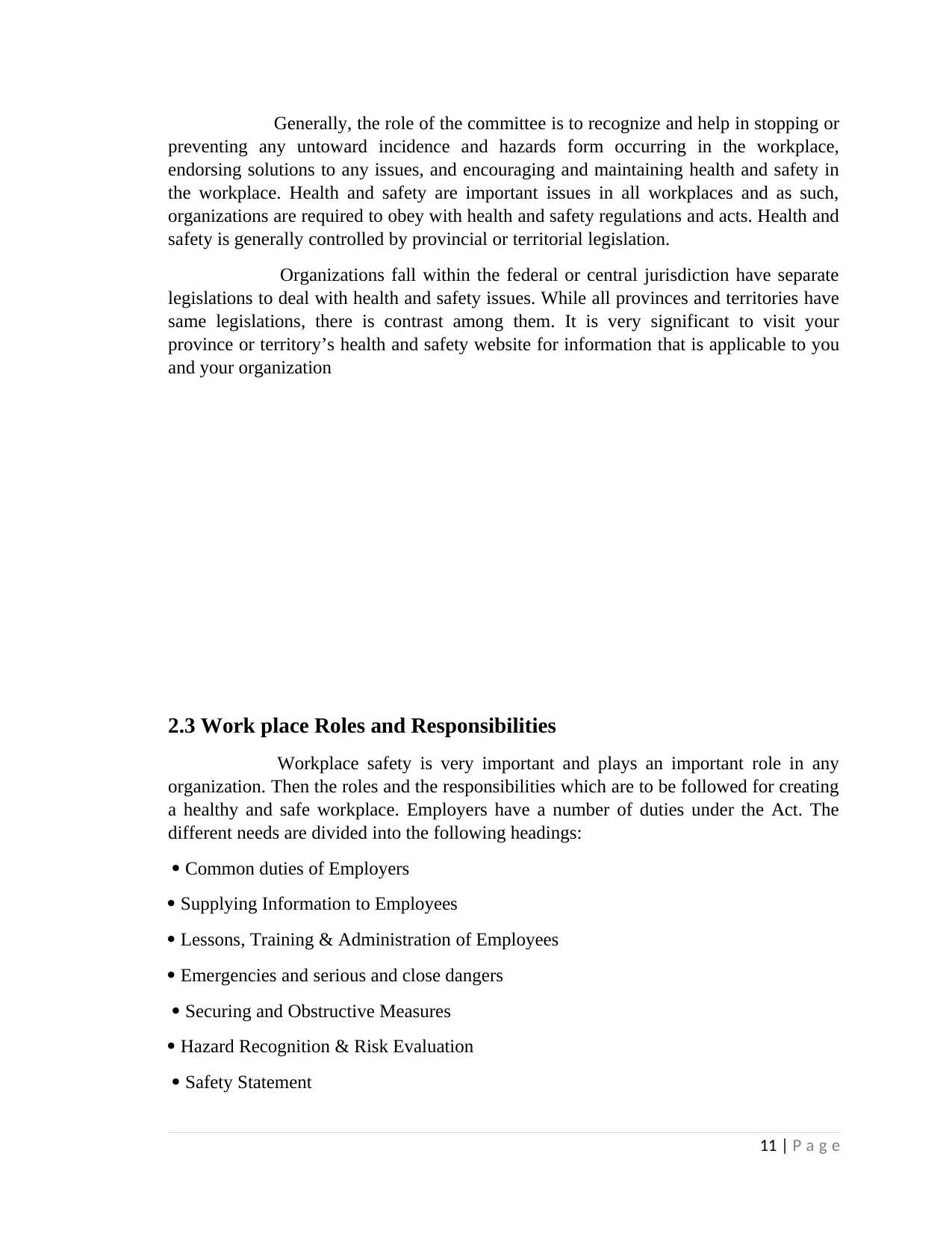
Generally, the role of the committee is to recognize and help in stopping or
preventing any untoward incidence and hazards form occurring in the workplace,
endorsing solutions to any issues, and encouraging and maintaining health and safety in
the workplace. Health and safety are important issues in all workplaces and as such,
organizations are required to obey with health and safety regulations and acts. Health and
safety is generally controlled by provincial or territorial legislation.
Organizations fall within the federal or central jurisdiction have separate
legislations to deal with health and safety issues. While all provinces and territories have
same legislations, there is contrast among them. It is very significant to visit your
province or territory’s health and safety website for information that is applicable to you
and your organization
2.3 Work place Roles and Responsibilities
Workplace safety is very important and plays an important role in any
organization. Then the roles and the responsibilities which are to be followed for creating
a healthy and safe workplace. Employers have a number of duties under the Act. The
different needs are divided into the following headings:
Common duties of Employers
Supplying Information to Employees
Lessons, Training & Administration of Employees
Emergencies and serious and close dangers
Securing and Obstructive Measures
Hazard Recognition & Risk Evaluation
Safety Statement
11 | P a g e
preventing any untoward incidence and hazards form occurring in the workplace,
endorsing solutions to any issues, and encouraging and maintaining health and safety in
the workplace. Health and safety are important issues in all workplaces and as such,
organizations are required to obey with health and safety regulations and acts. Health and
safety is generally controlled by provincial or territorial legislation.
Organizations fall within the federal or central jurisdiction have separate
legislations to deal with health and safety issues. While all provinces and territories have
same legislations, there is contrast among them. It is very significant to visit your
province or territory’s health and safety website for information that is applicable to you
and your organization
2.3 Work place Roles and Responsibilities
Workplace safety is very important and plays an important role in any
organization. Then the roles and the responsibilities which are to be followed for creating
a healthy and safe workplace. Employers have a number of duties under the Act. The
different needs are divided into the following headings:
Common duties of Employers
Supplying Information to Employees
Lessons, Training & Administration of Employees
Emergencies and serious and close dangers
Securing and Obstructive Measures
Hazard Recognition & Risk Evaluation
Safety Statement
11 | P a g e
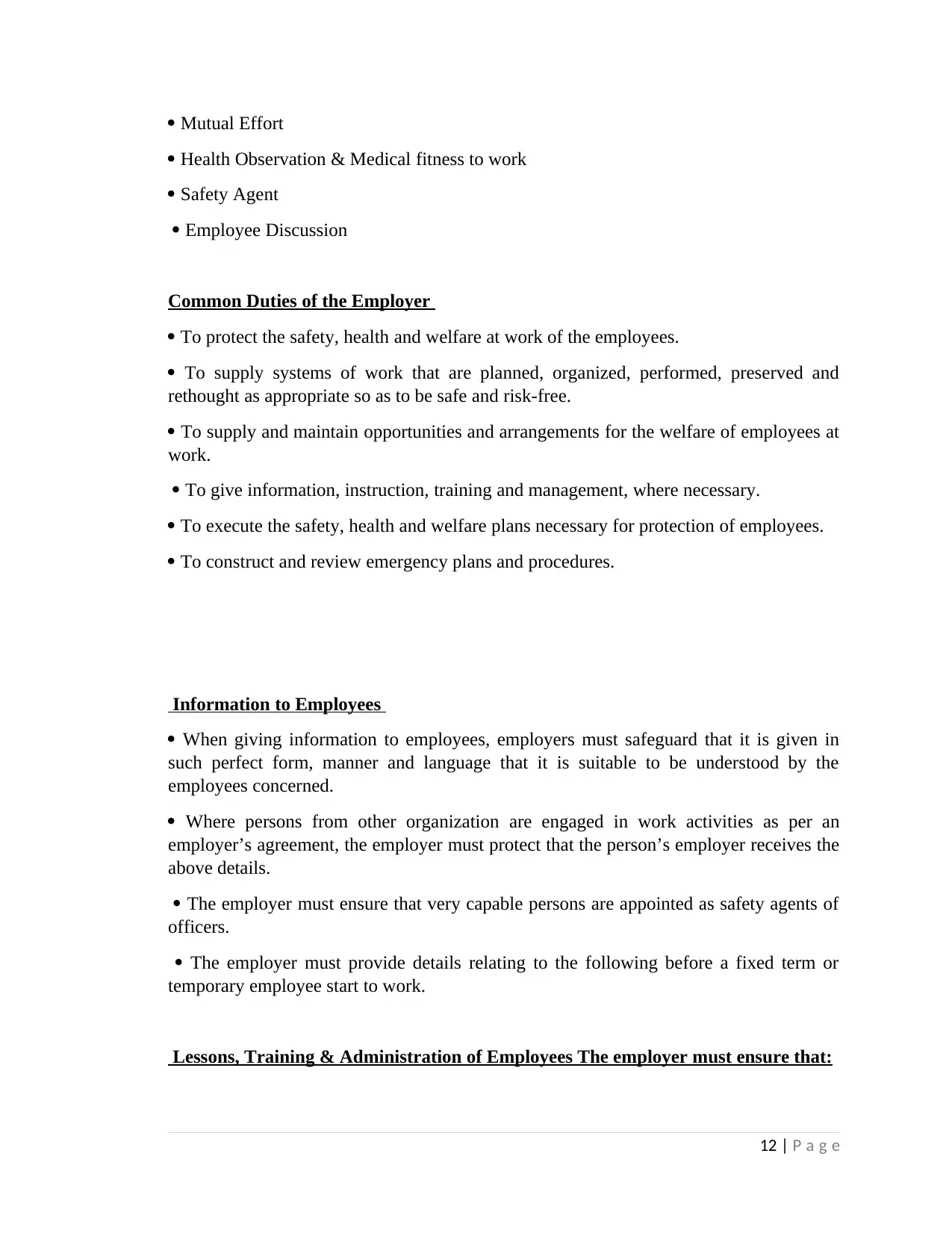
Mutual Effort
Health Observation & Medical fitness to work
Safety Agent
Employee Discussion
Common Duties of the Employer
To protect the safety, health and welfare at work of the employees.
To supply systems of work that are planned, organized, performed, preserved and
rethought as appropriate so as to be safe and risk-free.
To supply and maintain opportunities and arrangements for the welfare of employees at
work.
To give information, instruction, training and management, where necessary.
To execute the safety, health and welfare plans necessary for protection of employees.
To construct and review emergency plans and procedures.
Information to Employees
When giving information to employees, employers must safeguard that it is given in
such perfect form, manner and language that it is suitable to be understood by the
employees concerned.
Where persons from other organization are engaged in work activities as per an
employer’s agreement, the employer must protect that the person’s employer receives the
above details.
The employer must ensure that very capable persons are appointed as safety agents of
officers.
The employer must provide details relating to the following before a fixed term or
temporary employee start to work.
Lessons, Training & Administration of Employees The employer must ensure that:
12 | P a g e
Health Observation & Medical fitness to work
Safety Agent
Employee Discussion
Common Duties of the Employer
To protect the safety, health and welfare at work of the employees.
To supply systems of work that are planned, organized, performed, preserved and
rethought as appropriate so as to be safe and risk-free.
To supply and maintain opportunities and arrangements for the welfare of employees at
work.
To give information, instruction, training and management, where necessary.
To execute the safety, health and welfare plans necessary for protection of employees.
To construct and review emergency plans and procedures.
Information to Employees
When giving information to employees, employers must safeguard that it is given in
such perfect form, manner and language that it is suitable to be understood by the
employees concerned.
Where persons from other organization are engaged in work activities as per an
employer’s agreement, the employer must protect that the person’s employer receives the
above details.
The employer must ensure that very capable persons are appointed as safety agents of
officers.
The employer must provide details relating to the following before a fixed term or
temporary employee start to work.
Lessons, Training & Administration of Employees The employer must ensure that:
12 | P a g e
⊘ This is a preview!⊘
Do you want full access?
Subscribe today to unlock all pages.

Trusted by 1+ million students worldwide
1 out of 22
Related Documents
Your All-in-One AI-Powered Toolkit for Academic Success.
+13062052269
info@desklib.com
Available 24*7 on WhatsApp / Email
![[object Object]](/_next/static/media/star-bottom.7253800d.svg)
Unlock your academic potential
Copyright © 2020–2025 A2Z Services. All Rights Reserved. Developed and managed by ZUCOL.





